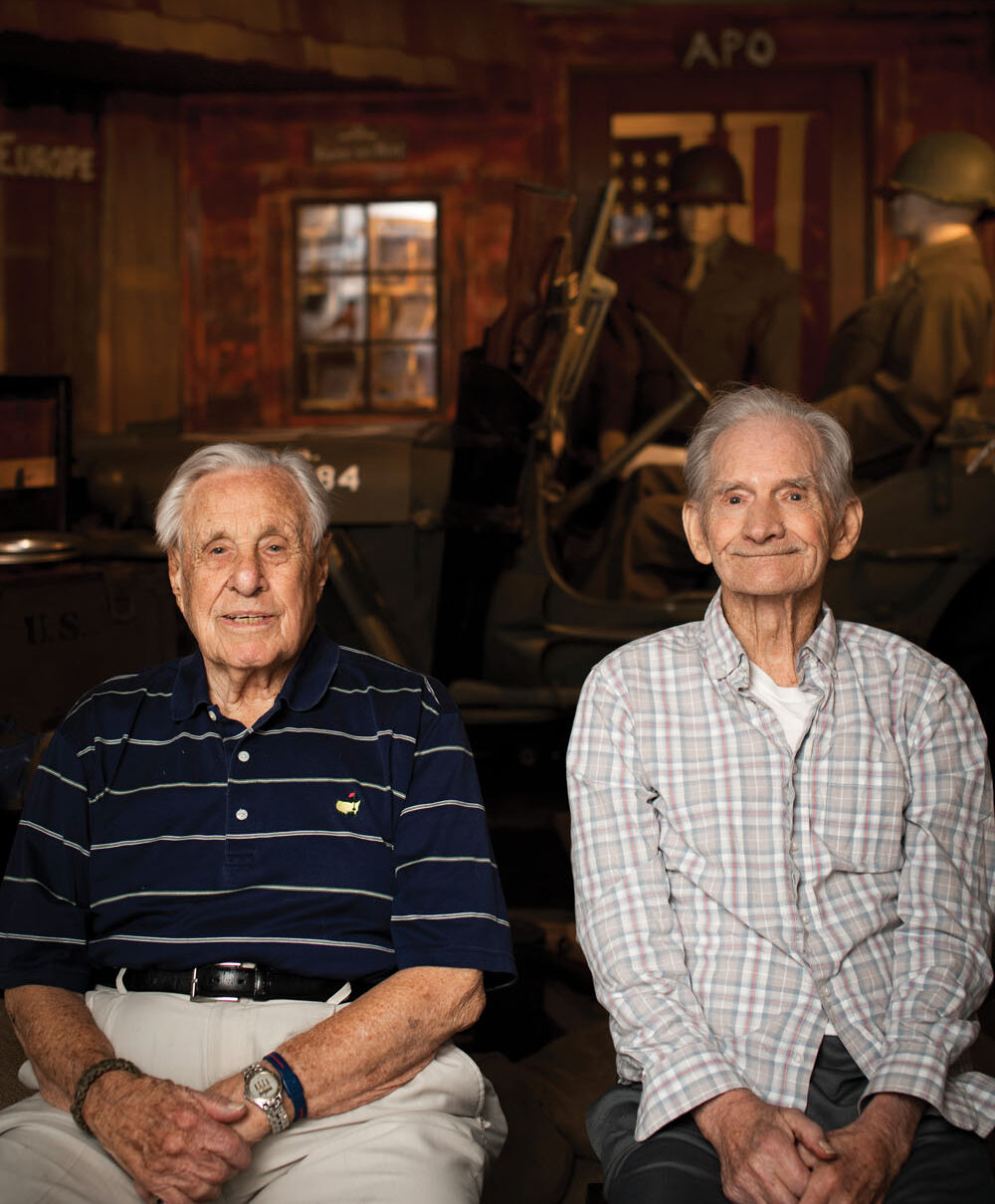
World War II Heroes are Here
Battle of the Bulge veteran Ed Cottrell (left), and Joe Cooper (right), are both 101. Cooper survived a kamikaze attack (see sidebar, page 33). They’ll join D-Day veteran George Sarros (age 98) to tell their stories. Portrait by Karin Strickland
As part of “A Walk Through WWII History,” a two-day event hosted by the Veterans History Museum of the Carolinas, visitors will have a rare opportunity to hear vivid stories told by the men who lived them. Joined by well-known author-historians, the local WWII veterans will take part in Q&As after their presentations.
Ed Cottrell and the Battle of the Bulge

Pilots of Ed Cottrell’s 493rd Fighter Squadron with P-47. Images used courtesy of Cottrell and the Veterans History Museum.

Ed Cottrell in the hot seat. Images used courtesy of Cottrell and the Veterans History Museum.
Ed Cottrell, 101, of Hendersonville, was called up in August 1942. He had taken part in College Pilot Training and joined the newly created Army Air Forces. Cottrell would go on to fly 65 missions in the European theatre, but the one on December 17,
1944, during the Battle of the Bulge, was different.
Cottrell’s mission was to fly over Koblenz — miles inside Nazi-controlled Germany — looking for Tiger (Panzer) tanks. His squadron found them and made bombing runs. “I noticed a Messerschmidt 109 firing at the plane in front of me,” Cottrell recalls. “Then, all of a sudden, I saw the 20mm cannon blinking out of the nose of his plane.”
Before he could make a defensive maneuver, Cottrell was hit. “There was a big pop, and black oil was all over my windshield,” he recalls. “The engine started misfiring.” Jettisoning his canopy and heading for Allied-controlled territory, he knew he would almost certainly have to crash land his aircraft.
Flying barely above stalling speed, Cottrell looked to his right and spied another Me 109. “Then I looked to my left, and saw another.” The two German fighters crisscrossed behind Cottrell’s plane and then — to his astonishment — fell into close formation with him. As he sputtered toward Allied airspace, Cottrell saw one of the German pilots make a circle with his thumb and forefinger. “Then,” he says with wonderment, “They both peeled off!” The American pilot dead-sticked his plane to a safe landing. “I got out and kissed the ground,” he says.
Once the war was over, Cottrell re-enlisted in the Reserves; in the decades since, he has returned many times to the places in Europe that figure into his personal story. Today, he proudly shares his memories and perspective: “It’s important for people to work together for the cause of freedom.”
George Sarros and D-Day

George Sarros, 98 a resident of Flat Rock, holds his Navy portrait. (contributed photo).

George Sarros’ LST 515 unloading and picking up troops and ambulances on D-Day at Omaha Beach. Image used courtesy of Sarros and the Veterans History Museum.
Drafted before he graduated high school, George Sarros of Flat Rock joined the U.S. Navy at age 18. (He’s now 98.) After boot camp he was assigned to the Amphibious Forces in New Orleans.
From there he boarded a brand-new ship, LST-515. The LSTs (short for Landing Ship, Tank) would be instrumental in the Allied success storming the beaches of Normandy. And that’s precisely where Sarros, his fellow 80-plus crew mates, and a convoy of other LSTs were bound. “I was assigned to the engine room,” he says.
But first the convoy landed in England, where they engaged in top-secret training. Dubbed Exercise Tiger, the rehearsal simulated what the LST crews could expect on the French beach landing. “We were completely loaded with ammunition, tanks, and infantry,” Cottrell recalls.
And then things went terribly wrong. Breakdowns in communication resulted in ships coming under “friendly fire,” and around midnight, several LSTs were attacked by German torpedo boats. LST-515 managed to avoid being hit, and the ship’s captain went against orders and remained in order to save overboard crewmen.
Sarros and his mates were able to rescue more than 100 men. “We were out there until 7am,” he recalls. All told, some 750 sailors lost their lives during the operation. “My ship was lucky,” says Sarros, who remains proud of his Captain’s decision. The details of Exercise Tiger would stay classified for decades thereafter.
Sarros would eventually take part in dozens of perilous wartime crossings of the English Channel aboard LST-515.
A Walk Through History

Joe Cooper’s ship, the USS Ommaney Bay, blows up after being hit by a Kamikaze. Cooper will share his incredible story of survival on November 4. (Image used courtesy of Cooper and the Veterans History Museum.)
The Veterans History Museum of the Carolinas (21 East Main St., Brevard) presents “A Walk Through History” Friday, Nov. 3 and Saturday, Nov. 4. Friday’s speakers, all authors and military historians, are James Scott (the event’s honorary chairman), Alex Kershaw, and Jonathan Jordan. Battle of the Bulge veteran Ed Cottrell will appear via Zoom link, and D-Day veteran George Sarros will attend in person. Another celebrated local veteran, 101-year-old Joe Cooper, a native of Brevard who lives in Black Mountain, will also attend in person to share his story of being a gunner’s mate. He was on board the USS Ommaney Bay when it was attacked — and eventually sunk — by a kamikaze pilot in January 1945, eight months before V-J Day. All three veterans will appear on Saturday to tell their stories and answer questions; Cottrell via Zoom and Sarros and Cooper in person. For a full schedule and pricing, see theveteransmuseum.org. (Saturday-only special is $50; grandchildren get in free.)
